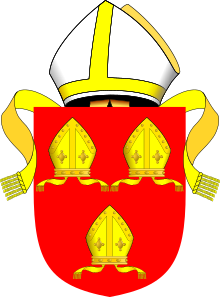





| Arms | Name of Bishop and heraldic blazon |
|---|---|
 | John Bird, Bishop 1542–1554 Escutcheon:Sable a mace Or in bend surmounted of a pastoral staff in bend sinister Argent headed Or on a chief Argent three shovellers also Argent. Contents |
 | George Cotes, Bishop 1554–1555 Escutcheon:Argent fretty Azure on a canton Or a lion rampant Sable. |
 | Cuthbert Scott, Bishop 1556–1559 Escutcheon:Argent a chevron between three pelicans' heads erased at the neck Sable. |
 | William Downham, Bishop 1561–1577 Escutcheon:Azure on a chevron between two doves Argent beaks and legs Gules and a wolf's head erased Argent in base a rose between two books Gules clasped Or. |
 | William Chaderton, Bishop 1579–1595 Escutcheon:Quarterly 1st & 4th Gules a cross potent Or 2nd & 3rd Argent a chevron between three crampirons Gules. |
 | Hugh Bellot, Bishop 1595–1596 Escutcheon:Or on a chief Gules three cinquefoils of the first. |
 | Richard Vaughan, Bishop 1597–1604 Escutcheon:Sable a chevron between three fleur-de-lis Argent. |
| Arms | Name of Bishop and heraldic blazon |
|---|---|
 | George Lloyd, Bishop 1604–1615 Escutcheon:Sable three horses' heads couped Argent. |
 | Thomas Morton, Bishop 1616–1619 Escutcheon:Quarterly Gules and Ermine in dexter chief and sinister base a goat's head erased Argent attired Or a fleur-de-lis in a crescent in fess point. |
 | John Bridgeman, Bishop 1619–1646 Escutcheon:Sable, ten plates in pile on a chief Argent a lion passant also Sable. |
 | Brian Walton, Bishop 1660–1661 Escutcheon:Three geese passant close. (Tinctures unknown) |
 | Henry Ferne, Bishop 1662 Escutcheon:Party per bend indented Argent and Gules a crescent for difference. |
 | George Hall, Bishop 1662–1668 Escutcheon:Sable three talbots' heads erased Argent langued Gules. |
 | John Wilkins, Bishop 1668–1672 Escutcheon:Argent on a pale engrailed cotised plain Sable, three martlets Or. |
 | John Pearson, Bishop 1673–1686 Escutcheon:Argent a chevron Erminois between three leaves Vert. |
 | Thomas Cartwright, Bishop 1686–1689 Escutcheon:Ermine a fess Sable between three fireballs inflamed.Crest:A wolf's head erased Or pierced through the neck with a spear Argent. |
 | Nicholas Stratford, Bishop 1689–1707 Escutcheon:Gules a fess humetty Or between three tressels Argent. |
 | Sir William Dawes, Bishop 1708–1714 Escutcheon:Argent on a bend Azure cotised Gules between six battle axes Sable three swans Or. |
 | Francis Gastrell, Bishop 1714–1725 Escutcheon:Chequy Argent and Sable on a chief Or three bucks' heads couped of the second. |
| Arms | Name of Bishop and heraldic blazon |
|---|---|
| Samuel Peploe, Bishop 1726–1752 Escutcheon:Azure on a chevron counter-embattled between three stringed bugle-horns Or a mitre with labels of the first. | |
 | Edmund Keene, Bishop 1752–1771 Escutcheon:Argent a talbot passant Sable collared Or on a chief indented Azure three crosslets of the third. |
 | William Markham, Bishop 1771–1776 Escutcheon:Azure on a chief Or a lion issuant Gules. [3] |
 | Beilby Porteus, Bishop 1776–1787 Escutcheon:Azure a book Or between two mullets in chief and a saltire humetty in base Argent. |
 | William Cleaver, Bishop 1788–1800 Escutcheon:Sable two bars between three castles masoned Or. |
 | Henry Majendie, Bishop 1800–1809 Escutcheon:Or on a mount Vert a tree between a serpent erect and a dove close Proper. |
 | Bowyer Sparke, Bishop 1810–1812 Escutcheon:Chequy Or and Vert a bend Ermine. |
 | George Henry Law, Bishop 1812–1824 Escutcheon:Argent on a bend engrailed between two cocks Gules three pierced mullets of the first. |
 | Charles James Blomfield, Bishop 1824–1828 Escutcheon:Quarterly per fess indented Or and Azure a bend Gules. |
 | John Bird Sumner, Bishop 1828–1848 Escutcheon:Ermine two chevrons Gules. |
 | John Graham, Bishop 1848–1865 Escutcheon:Argent on a pile Azure a dove close bearing in her beak an olive branch Proper on a chief Sable a cross potent Argent between two escollops Or. |
 | William Jacobson, Bishop 1865–1884 Escutcheon:Argent a chevron Gules between three trefoils slipped Sable on a chief also Sable an estoile Silver. |
 | William Stubbs, Bishop 1884–1889 Escutcheon:Sable on a bend nebuly Or between two bezants each charged with a pheon also Sable three buckles Proper. |
 | Francis Jayne, Bishop 1889–1919 No arms known. |
| Arms | Name of Bishop and heraldic blazon |
|---|---|
 | Luke Paget, Bishop 1919–1932 Escutcheon:Sable on a cross engrailed between in the first and fourth quarters an eagle displayed and in the second and third an heraldic tyger passant Argent an escallop also Sable. |
 | Geoffrey Fisher (later Baron Fisher of Lambeth), Bishop 1932–1939 Escutcheon:Argent a fess wavy between three fleur-de-lys Sable. |
 | Douglas Crick, Bishop 1939–1955 No arms known. |
 | Gerald Ellison, Bishop 1955–1973 No arms known. |
 | Victor Whitsey, Bishop 1974–1981 No arms known. |
 | Michael Baughen, Bishop 1982–1996 No arms known. |
 | Peter Forster, Bishop 1996–2019 No arms known. |
 | Keith Sinclair, acting Bishop 2019–2020 No arms known. |
 | Mark Tanner, Bishop since 2020 No arms known. |

Baron Monk Bretton, of Conyboro and Hurstpierpoint in the County of Sussex, is a title in the Peerage of the United Kingdom. It was created by letters patent on 4 November 1884 for the Liberal politician John George Dodson. He was succeeded by his son, the second Baron. He was notably chairman of the London County Council from 1929 to 1930. As of 2022 the title is held by the latter's grandson, the fourth Baron, who succeeded his father in that year.

Baron Ardenerie was a title in the Peerage of Ireland which was created in May 1580 for John Bourke, who died on 24 November of that year, and became dormant in 1591 on the death of the second Baron.

Earl of Clanricarde is a title that has been created twice in the Peerage of Ireland, first in 1543 and again in 1800. The former creation became extinct in 1916 while the 1800 creation is extant and held by the Marquess of Sligo since 1916.
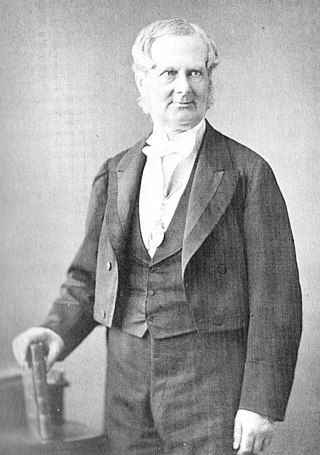
Sir John Bernard Burke, was a British genealogist and Ulster King of Arms, who helped publish Burke's Peerage.
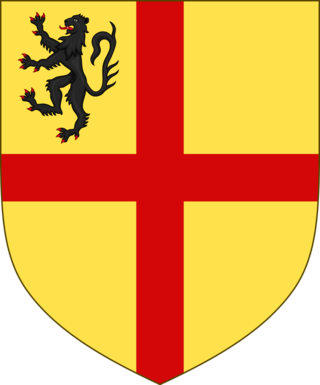
Richard Óg Burke, 2nd Clanricarde or Mac William Uachtar was an Irish chieftain and nobleman who was the son of Sir Ulick Burke or Uilleag de Burgh, 1st Clanricarde (d.1343/1353).

Elizabeth de Burgh, Duchess of Clarence, suo jure 4th Countess of Ulster and 5th Baroness of Connaught was a Norman-Irish noblewoman who married Lionel of Antwerp, 1st Duke of Clarence.

John Vesey or Veysey was Bishop of Exeter from 1519 until his death in 1554, having been briefly deposed 1551–3 by King Edward VI for his opposition to the Reformation.

John de Burgh was an Irish noble who was the son of Richard Óg de Burgh, 2nd Earl of Ulster and his wife, Margarite.

Baron Harington, of Aldingham, was a title in the Peerage of England. On 30 December 1324 John Harington was summoned to parliament. On the death of the 5th baron in 1458, the barony was inherited by the heir to the barony of Bonville, with which title it merged in 1461, until both baronies were forfeited in 1554.
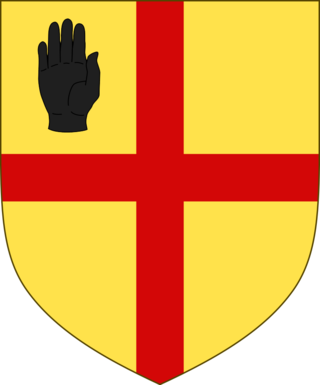
Baron Bourke of Castleconnell was a title in the Peerage of Ireland created on 16 May 1580 for Sir William Bourke. The eighth baron was attainted and the barony forfeited in 1691.

Viscount Mayo is a title that has been created twice in the Peerage of Ireland, both times for members of the Bourke family. The first creation came in 1627 in favour of Tiobóid na Long Bourke, also known as Theobald Bourke. He was the son of Sir Richard Bourke, 18th lord of Mac William Iochtar, and Gráinne O'Malley. Miles, the 2nd Viscount, was created a baronet in the Baronetage of Nova Scotia in c. 1638.
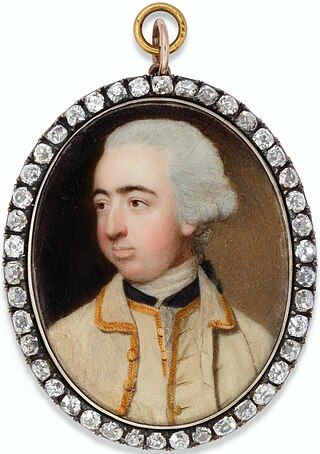
Henry de Burgh, 1st Marquess of Clanricarde, KP, PC (Ire), styled Lord Dunkellin until 1782 and The Earl of Clanricarde from 1782 until 1789, was an Irish peer and politician who was MP for County Galway (1768) and Governor and Custos Rotulorum of County Galway (1792–97).
Ulick Burke, 3rd Earl of Clanricarde, styled Lord Dunkellin until 1582, was an Irish peer who was the son of Richard Burke, 2nd Earl of Clanricarde and Margaret O'Brien.
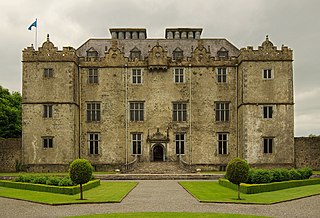
Richard Burke, 6th Earl of Clanricarde was an Irish peer.

Richard Burke, 8th Earl of Clanricarde ; styled Lord Dunkellin until 1687; was an Irish peer who served as Custos Rotulorum of Galway.
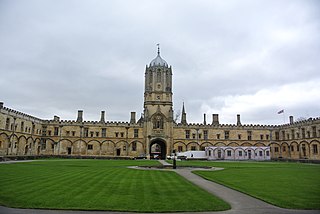
Michael Burke, 10th Earl of Clanricarde, styled Lord Dunkellin until 1722, was an Irish peer who was Governor of Galway (1712) and a Privy Counsellor in Ireland (1726).

Richard Bacach Burke, 11th Clanricarde or Mac William Uachtar was an Irish chieftain and noble who was the ancestor of the Burkes of County Galway.

Ulick Óge Burke, 8th Clanricarde or Mac William Uachtar was an Irish chieftain and noble who was Clanricarde for barely a year.

Richard Óge Burke, 7th Clanricarde or Mac William Uachtar was an Irish chieftain and noble who was the ancestor of the Burkes of Derrymaclachtna.

Baron Bourke of Brittas, of the County of Limerick, was a title in the Peerage of Ireland created on 17 February 1618 for Theobald Bourke.
The Armorial Bearings of the Bishops of Chester, compiled by the Cheshire Heraldry Society